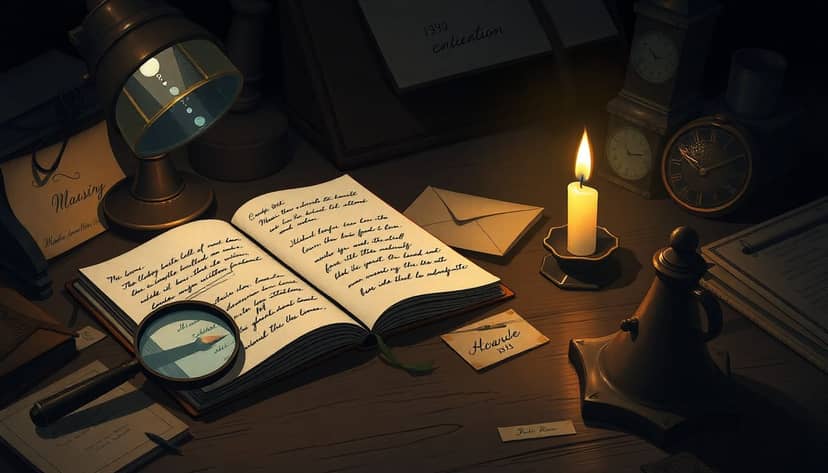Table of Contents
Plotting a mystery novel can feel tricky, especially when you’re juggling mystery clues, shady suspects, and a detective you want your readers to root for. Honestly, figuring out where to start is probably driving you a bit nuts right now—I totally get it.
Here’s the good news: stick around, and you’ll see there’s actually a straightforward way to figure out your crime, build interesting characters, sprinkle in sneaky clues, and still keep your readers entertained and clueless till the big reveal.
Ready to finally untangle the mystery behind the mystery? Let’s jump into it!
Key Takeaways
- Start by choosing an intriguing main crime with believable motivations.
- Create a relatable detective with personal stakes in solving the mystery.
- Give your villain realistic motives and opportunities, making them complex enough to suspect several characters.
- Carefully lay out key clues and evidence scattered logically throughout the story.
- Include red herrings to mislead readers, but keep these realistic rather than random.
- Clearly outline motives to maintain tension and suspicion among multiple characters.
- Build suspense steadily with cliffhangers and unexpected reveals along the way.
- Divide your plot into logical parts to clearly present setup, tension, and resolution.
- Create a timeline to realistically track events, locations, and alibis.
- Write a resolution that’s logical, satisfying, and neatly wraps up all subplots.
- Carefully review your draft to catch and fix plot holes or inconsistencies.

Step 1: Choose the Main Crime for Your Novel
The crime is at the heart of any mystery, and a compelling one will keep your reader hooked until the very last page.
Start by choosing a crime that’s intriguing enough to grab attention right away—murders, kidnappings, thefts, or disappearances are popular for a reason, accounting for a substantial 17–20% of adult fiction sales in the U.S. alone.
Be sure to pick something you know you can realistically depict with believable motives and consequences.
Also, don’t think you must limit yourself to traditional scenarios; adding an unexpected detail or unusual twist can breathe new life into familiar setups.
For instance, instead of a standard murder investigation, you could explore a murder staged to look like an accident or suicide, making the case more puzzling.
Not sure how to begin brainstorming? You can always get started with some helpful mystery-focused horror story plot ideas to stimulate creativity or explore prompts online for fresh inspiration.
Step 2: Create Your Protagonist (Detective or Sleuth)
Your detective—or amateur sleuth—should be memorable and relatable enough that readers genuinely care about them.
Give your protagonist a clear personal reason to investigate the crime, beyond it simply being their job.
Maybe they knew the victim, have a personal connection to the case, or have a past they’re trying to redeem.
Think of classic characters like Sherlock Holmes with his quirky personality and intense intellect, or Agatha Christie’s Miss Marple, whose cleverness is hidden behind a folksy exterior.
Building a detailed character profile can help: jot down their background, strengths, flaws, quirks, and why they’re particularly suited to this case.
Show your detective’s humanity too—they shouldn’t be perfect.
If your character struggles with something readers also have experienced—such as anxiety, loss, or even hesitations about new technology—it allows for genuine connection.
You can even find inspiration for complex characters by exploring some engaging realistic fiction writing prompts.
Step 3: Develop a Strong Villain (Unknown Culprit)
Every good mystery needs a compelling villain—the unknown person behind the crime who is as fascinating as the protagonist.
A convincing antagonist doesn’t do terrible things for no reason: ensure your culprit has clear, relatable motives like greed, revenge, or self-preservation.
Realistically portray their opportunity and means to carry out the crime as well.
Remember, a great villain shouldn’t just be evil—the most intriguing villains have complex layers, too.
Consider creating an antagonist who appears almost sympathetic or understandable from certain angles, adding emotional depth and complexity to your story.
The villain needs to be believable enough for readers to suspect several characters throughout the novel.
You can even outline the villain’s actions and motives beforehand, then drop subtle clues so readers can eventually piece it all together in a satisfying way.
Also, think about mixing things up—a villain who initially appears harmless or trustworthy is always intriguing.

Step 4: Outline the Main Clues and Evidence
Alright, you’ve got your main characters and your crime figured out—now you have to carefully place clues and evidence that’ll guide readers through your mystery.
Here’s where the puzzle pieces start to fall into place. Start by creating a simple list: include physical evidence like fingerprints or an unusual murder weapon, and make note of who has access to each clue.
Aside from physical evidence, don’t overlook eyewitness testimony, suspicious behavior, or past secrets of the characters involved.
Your goal here is to leave a breadcrumb trail, gradually providing enough clues that allow attentive readers to piece things together over time.
Try to include meaningful clues along the way rather than dropping everything at once near the end—spread the mystery and the fun.
If you’re ever stuck for ideas, try out a helpful horror and mystery idea generator to spark creative clues and scenarios that’ll nicely fit your plotline.
Step 5: Use Red Herrings to Mislead Readers
Let’s be honest—it’s boring if readers know who’s guilty from the start.
That’s where red herrings come in; they’re misleading clues or details that make your readers guess the wrong culprit or motive.
But don’t go overboard—keep red herrings believable and close enough to the main plot to actually fool readers.
For example, you could highlight a minor disagreement between the victim and a friend that makes readers suspect friendship gone wrong, but later reveal it was nothing.
This builds suspense and surprises, keeping things engaging without frustrating your reader.
Just be careful not to throw in random, irrelevant details; red herrings must make sense within the story arc, even if they’re designed to mislead.
Step 6: Clearly Establish Motives for the Crime
Crime fiction thrives on believable motives—your villain needs solid reasoning behind their criminal actions.
Murder mysteries often revolve around classic motives like greed, jealousy, love, revenge, or fear of exposure—but there’s always room for more personal, unusual motivations too.
Make sure multiple characters appear to have compelling motives, increasing story tension and keeping readers guessing until the end.
Maybe one character holds a grudge because their proposal was rejected years ago, another benefits financially from inheritance, and a third has hidden political secrets they desperately want buried.
This not only mixes up plot twists, but gives your book depth and realism readers crave.
Step 7: Build Suspense Throughout the Plot
Suspense is your novel’s lifeline—without it, readers don’t feel motivated to turn pages.
Develop suspense gradually, steadily raising the stakes to intensify reader engagement.
Consider ending chapters on cliffhangers or reveal surprising information without further explanation until later, encouraging readers to continue.
You might insert shorter, sharper dialogue scenes during tense moments, alternating between breakthroughs and setbacks to create a rhythm of suspense and anticipation.
You can also introduce secondary threats, such as someone close to your protagonist getting into trouble, or giving your hero a tight timeline that adds urgency.
Step 8: Structure the Story into Logical Parts or Acts
Breaking your novel into clear sections or acts makes plotting much smoother—not just for you, but for readers trying to follow the action too.
A simple technique used by many novelists: divide the story into three main acts—setup, confrontation, and resolution.
The beginning sets the crime scene and introduces characters, motives, and initial clues.
The middle act complicates matters, adding tension and weaving clues and red herrings together into twists.
The final act resolves everything, escalating action until the satisfying reveal of the culprit.
If you’re unsure how best to organize your chapters or scenes, check out some creative book structuring strategies and titling tips that work well for mystery fiction.
Step 9: Organize Plot Points into a Clear Timeline
Plotting a mystery can easily become confusing, especially when you’re juggling timelines for clues, red herrings, interrogations, and alibis.
Creating a straightforward timeline of events helps authors keep track of important details and minimizes plot holes.
Try noting down what happens each day or hour within the story—where suspects were at crucial moments, who saw what, and when information was revealed to the protagonist.
There are online timeline-building tools, or you can just grab some sticky notes and map out major events visually on a wall or board.
Keep it flexible enough to move scenes around for better pacing or tighter suspense as you go.
Step 10: Write a Clear and Satisfying Resolution
This is perhaps the trickiest—but most rewarding—part of writing a mystery.
A great resolution ties up all loose ends and makes the reader feel satisfied they’ve solved a tricky puzzle.
All established clues and events must logically point toward your villain’s reveal; readers should never feel cheated or intentionally misled.
Your protagonist should play a key role, logically piecing the case together and presenting clear proof.
Avoid overly complicated reveals or convoluted explanations; simplicity is often your friend here—answer key questions clearly.
Also, consider wrapping up subplots too—perhaps your detective resolves personal conflicts or overcomes something that’s troubled them since the beginning.
Step 11: Review Your Draft for Any Plot Issues or Gaps
You’re nearly finished—now it’s time to carefully review that first draft for potential plot holes, inconsistencies, or pacing issues.
Does every clue lead to a believable conclusion? Do all the characters’ actions align with their motives?
Keeping a notebook or document listing problems as you spot them can help you keep track of revisions needed.
If you’re stuck, having a fresh set of eyes can make a world of difference—consider finding beta readers to point out confusing areas or overlooked inconsistencies.
Lastly, take breaks between revisions—stepping away helps you approach your story with fresh eyes and sharper judgment.
FAQs
Create clues by considering how real crimes often unfold. Incorporate subtle details early in the narrative so that the resolution makes logical sense. Balance clear evidence with subtle hints to maintain suspense without frustrating readers.
Use plausible false leads to divert suspicion temporarily. Introduce convincing alternative suspects or deceptive evidence that fits another narrative, ensuring these distractions align naturally within the story rather than feeling tacked-on or obvious.
Link motivations closely with your characters’ personalities, histories, and ambitions. Strong motives should arise logically from past conflicts or emotional stakes, making the crime believable and deepening reader engagement with both hero and villain.
Use a visual timeline or narrative outline to track major events according to when they actually occur. Include placement of clues, character introductions, and revelations to help avoid continuity issues and clearly guide readers through your story.



